The AMD Ryzen AI 9 HX 370 Review: Unleashing Zen 5 and RDNA 3.5 Into Notebooks
by Gavin Bonshor on July 28, 2024 9:00 AM ESTGraphics Performance
Moving on to gaming performance, AMD has upgraded their integrated graphics within Strix Point to the RDNA 3.5 architecture. RDNA 3.5 improves things over RDNA 3 within Phoenix and Hawk Point in multiple areas. One thing RDNA 3.5 does is greatly increase the GPU's capacity to execute complicated graphics operations more effectively by optimizing key things such as texture sampling and interpolation. Upgrading the memory management in RDNA 3.5 also allows for better overall power optimization and data handling to address major GPU performance issues.
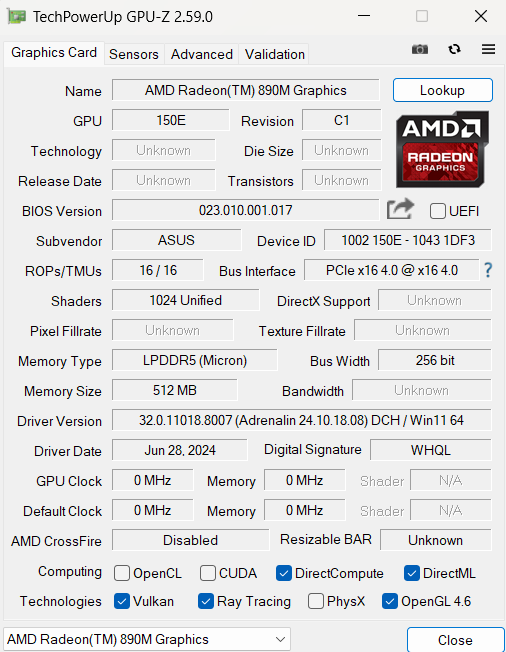
Screenshot of the AMD Ryzen AI 9 HX 370 with Radeon 890M in GPU-Z
All of the improvements and upgrades over RDNA 3 should theoretically translate into better real-world gaming performance. Generally, any form of mobile SoC doesn't quite bring the power or graphics compute to the same level as discrete graphics, which have more die area to play with, a higher transistor budget at the manufacturing level, and more power.
As the new AMD Radeon 890M graphics is the direct successor to the Radeon 780M, it does have an obvious competitor in the previous Phoenix and Hawk Point mobile SoCs. Until Intel launches its upcoming Lunar Lake mobile SoC, the other competitor is Intel's current Meteor Lake-based Arc Xe LPG integrated graphics. Another contender is AMD's own RDNA 3.5 sibling to the Radeon 890M in the Ryzen AI 9 HX pairing, which is the Radeon 880M and is found in the Ryzen AI 9 365. The main difference between the Radeon 890M and the 880M is in the number of graphic cores or compute units (CUs). The Radeon 890M features 16 x CUs, while the Radeon 880M comes with 12 x CUs.
As integrated graphics get their memory from the primary pool of DRAM installed, slower system memory can be hindered by bandwidth. AMD's Ryzen AI 300 series allows for both DDR5-5600 and LPDDR5x-7500, which is what the ASUS Zenbook S 16 we're testing uses.
For this review, we will focus on gaming performance at 1080p, which is the most commonly used gaming resolution according to the latest Steam survey. Given that these are mobile chips, we've opted for middle-of-the-road settings using the Medium preset. Despite the advancements in integrated graphics, they still lack the horsepower of discrete graphics.
Gaming Performance @ 1080p Medium Settings
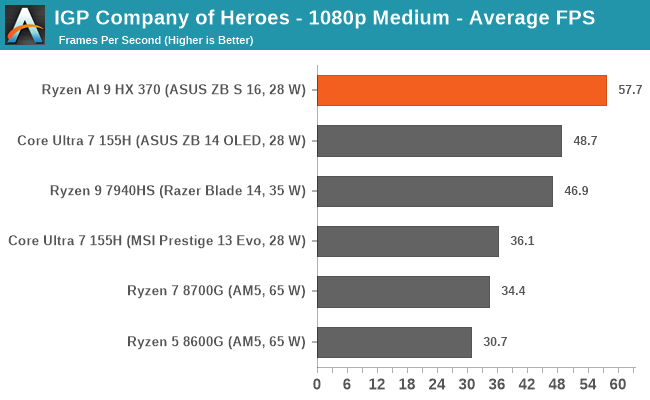
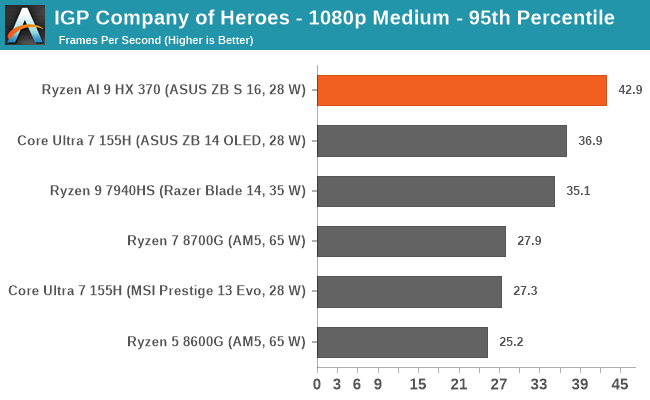
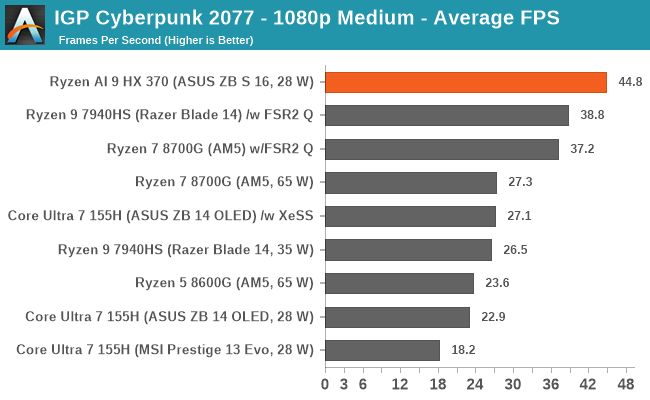
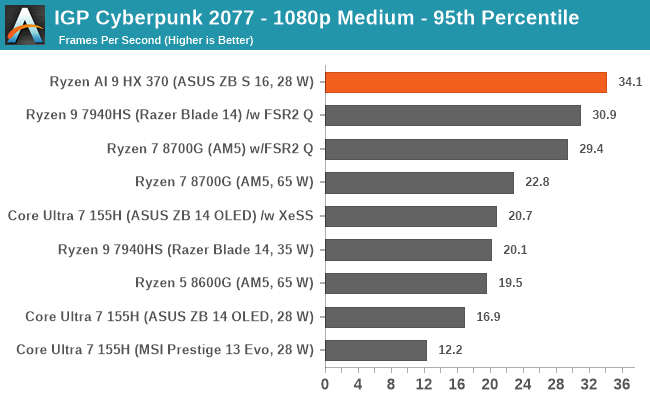
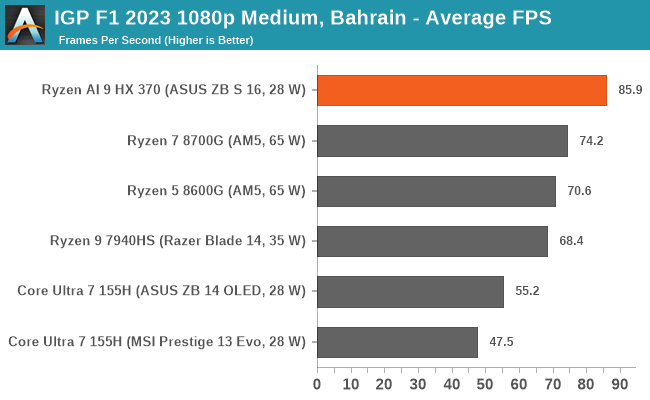
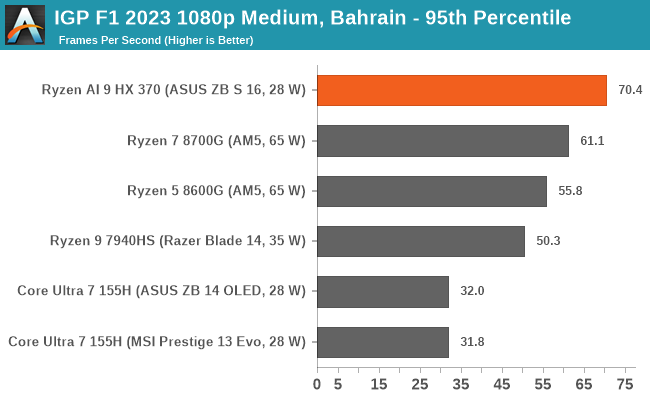
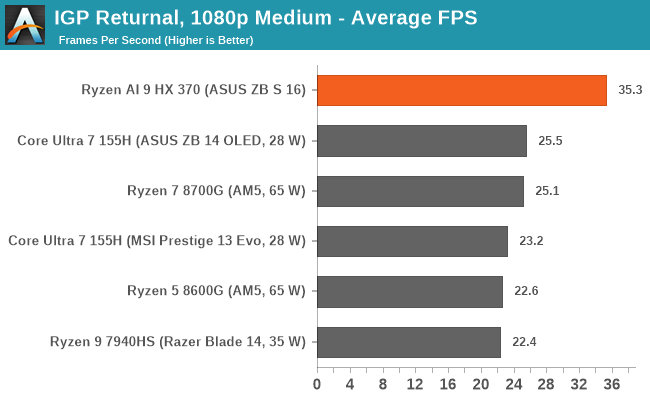
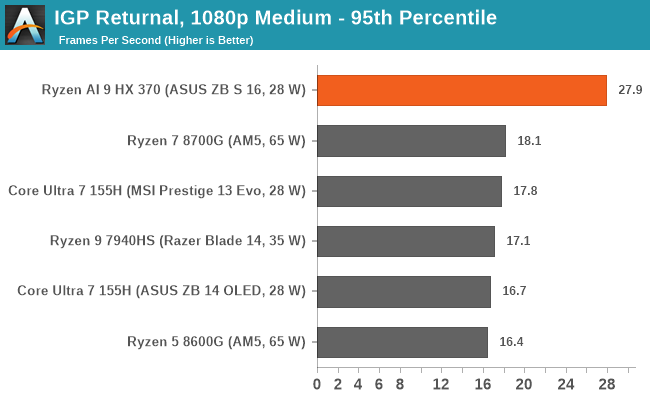
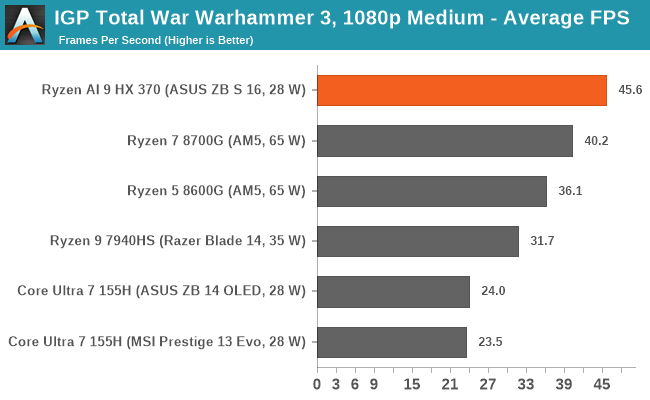
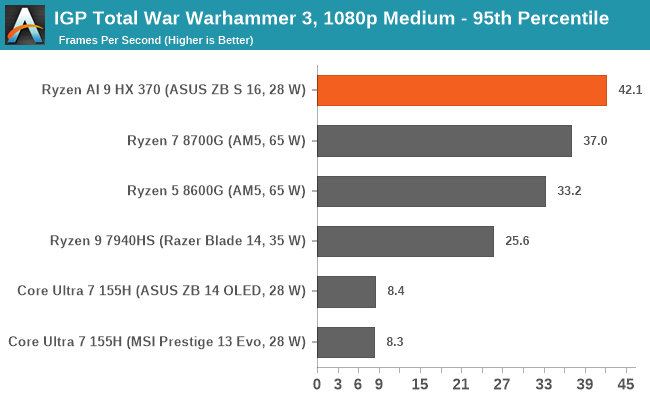
Looking at the performance of the Radeon 890M within the Ryzen AI 9 HX 370, we can see that the combination of Zen 5/Zen 5c cores and the latest RDNA 3.5 graphics performs consistently well at 1080p. Given the Ryzen AI 9 HX 370 has a higher core count with 12C/24T (4 x Z5 + 8 x Z5c) compared to the Ryzen 9 7940HS (8C/16T), the latest Soc also has a higher number of graphics compute units (16 CUs vs. 12 CUs). On top of that, you also have to factor in the jump in CPU architecture to Zen 5 over Zen 4; the latest SoC certainly does have an advantage.
In Company of Heroes 3 at medium settings, this game can simultaneously be very taxing on the CPU cores and graphics. The Ryzen AI 9 HX 370 with the Radeon 890M graphics is around 23% faster than the Ryzen 9 7940HS/Radeon 780M, although to make things a level playing field, we are testing the 7940HS at 35 W.
We also see good gains over the Ryzen 9 7940HS and Intel's Core Ultra 7 155H, which is a 6P+8E/22T chip with their Arc Xe integrated graphics that has 8 x CUs in Cyberpunk 2022 and F1 2023, but we are also seeing an uptick of 38% compared to the Core Ultra 7 155H in Returnal; for contrast, it beats the Ryzen 7940HS by around 57%.
Overall, AMD's latest RDNA 3.5 graphics architecture and the Zen 5 pairing certainly improve integrated graphics performance. This is a good thing, although integrated graphics are still not quite there when it comes to achieving a consistent 1080p/60fps in demanding titles. Games such as MOBAs, including League of Legends and DOTA 2, and other less demanding games will certainly play well on this iGPU.










72 Comments
View All Comments
Dante Verizon - Sunday, July 28, 2024 - link
Why are you comparing an ultra-thin design to a CPU with PL2 at almost 90w? The notebookcheck tests show that the Zenbook runs up to 50% slower than the ProArt chassy.Ryan Smith - Sunday, July 28, 2024 - link
Sorry, which notebook are you referring to? We have multiple Zenbooks here.Terry_Craig - Sunday, July 28, 2024 - link
He's probably talking about the Zenbook in the review: https://www.notebookcheck.net/Asus-Zenbook-S-16-la...Strix performs much worse on the Zenbook than inside the ProArt, probably due to more aggressive power and temperature management.
Ryan Smith - Sunday, July 28, 2024 - link
It's definitely not a high performance chassis, despite being 16-inches. The default TDP is just 17 Watts; AMD asked reviewers to bump it up to 28W.But this is what AMD sent out for review. Given the wide range of laptop TDPs out there, these review unit laptops can never cover the full spectrum. So it's more a reflection of what power level/form factor the chipmaker is choosing to prioritize in this generation.
The Hardcard - Sunday, July 28, 2024 - link
What is the 90W laptop in this review? The other laptops are listed at 28W and 35W here. I did not see any indication of the power specifications of the ProArt on the other site, just some numbers provided. I strongly suspect that laptop is running at top TDP, 45-54W.So, like, a different comparison.
Terry_Craig - Sunday, July 28, 2024 - link
https://www.notebookcheck.net/AMD-Ryzen-9-7940HS-P...Depending on the model, the 7940HS goes up to 100w.
The Hardcard - Monday, July 29, 2024 - link
But, is the 7940HS pulling 100w in this review instead of the reported 35w? Otherwise,, what is the point of the complaint?https://www.ultrabookreview.com/69005-asus-proart-...
The HX 370 is in a different chassis pulling 80w sustained. Does that make the 35w vs 28w happening here more fair? I mean, if what the chips can draw elsewhere somehow matters here at all?
eastcoast_pete - Monday, July 29, 2024 - link
It matters if one wants to look at the maximum performance possible, regardless of power draw. But, in addition to what Ryan wrote, the attraction of the HX Series to me is the strong performance at lower power draws. I would have actually liked to see performance comparisons at 17 W, which IMHO is of special interest in such thin and light notebooks. The higher end (> 50 W) will be if interest for Strict Halo, which as far as I can tell is supposed to take on notebooks with smaller dGPUs.ET - Sunday, July 28, 2024 - link
From the benchmarks here, the 370 looks somewhat disappointing on the CPU front, with some losses to 8 cores Zen 4. A hybrid architecture is always a problem. I wonder if future scheduling changes will help or if the small 8MB L3 for the Zen 5c cores is a problem that can't be overcome.The new GPU however looks like a good upgrade over the previous gen.
nandnandnand - Sunday, July 28, 2024 - link
It's hybrid with different cache amounts, but it's also two CCXs instead of one after 3.5 generations of simple 8-cores. It's hard to say what's screwing it up.Phoronix's review was more positive for the CPU. The main benefit is power efficiency:
https://www.phoronix.com/review/amd-ryzen-ai-9-hx-...
The reviews I looked at didn't look too good for the GPU. Maybe it will do better with more power, but what it really needs is memory bandwidth. Hopefully AMD brings some Infinity Cache to its mainstream 128-bit APUs in the future.